Understanding your customers is key to growing a successful online store. The right WooCommerce reporting and analytics plugins can help you dive into essential data to boost sales and refine your strategies.
However, with so many options available, finding the right fit can feel overwhelming. Plus, not every plugin offers the same features, and some might come with a learning curve or extra costs.
We’ve tested the most popular plugins out there, so you don’t have to. These tools can give you a better look at your store’s performance, letting you track sales, discover customer trends, and improve conversion rates.
To track our own website’s analytics, we use MonsterInsights to handle everything from conversion tracking and referral link analysis to monitoring visitor demographics. It helps us see which pages get the most traffic, how visitors engage with our content, and where we can improve.
In this article, we’ll share our top picks for WooCommerce reporting and analytics plugins, helping you find the right one for your store’s needs.
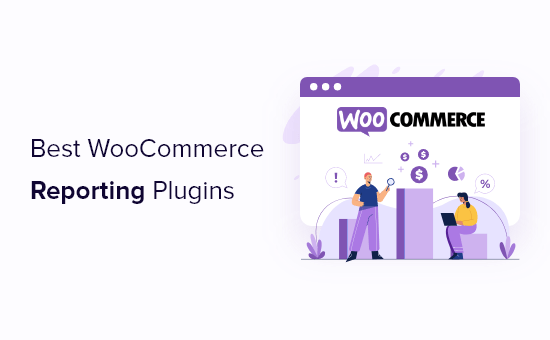
Quick Pick – The Best WooCommerce Reporting and Analytics Plugins
Looking for a quick summary? Here’s a snapshot of the analytics tools we’ll cover in this post:
| # | Analytics Tool | Best For | Pricing | Free Version |
| 🥇 | MonsterInsights | Ease of use and Google Analytics Access | $199.50 per year | ✅ |
| 🥈 | WP Mail SMTP | Email tracking | $39 per year | ✅ |
| 🥉 | FunnelKit Automations | Email campaigns + customer journey | $249.50 per year | ✅ |
| 4 | Product Sales Report for WooCommerce | Sales report generation | $199 per year | ✅ |
| 5 | Conversios | Businesses using Google Ads and Google Merchant | Free | ✅ |
| 6 | Abandoned Cart for WooCommerce | Tracking recovered abandoned carts | Free | ✅ |
| 7 | Metorik | Large stores | Starting at $20 per month | ❌ |
How We Test & Review WooCommerce Reporting Plugins
Wondering how we picked the WooCommerce reporting plugins featured in this list? We’ll go over our process now.
When reviewing each WooCommerce reporting and analytics plugin, we first looked at its ease of use.
Not everyone is a tech expert, so we looked for plugins with user-friendly dashboards, clear instructions, and intuitive settings. That way, tracking your WooCommerce store’s performance will be much more manageable.
Being able to customize your reports to show the exact information you need is a big plus. The more flexible the reporting, the better you can tailor it to your online store needs. So, we also favored tools that offer this option.
Here are other factors we took into consideration:
- Metrics and reporting features. Different plugins offer different types of data and reports. Some may focus on basic sales metrics like revenue and conversion rates, while others provide more in-depth insights like customer behavior, cart activity, and marketing campaign results. We made sure to evaluate every plugin’s features as a whole.
- Real-time data tracking. We looked for real-time tracking tools for users who want to closely monitor their store’s activity. With real-time monitoring, you can see what’s happening as it happens, whether you want to track a flash sale or the effects of a new campaign.
- Integration with other tools. We reviewed how these plugins work with other popular tools like Google Analytics, CRM systems, email marketing software, and more. That way, you can easily share data across different platforms or track all your stats in one place.
- Advanced Features. We looked for standout features that could give your store an extra advantage. This could include things like automated email workflows or sales funnels. Advanced features can make a big difference in how effectively you can grow your store.
- Performance Impact. Some plugins may slow down your website if they are resource-heavy. With this in mind, we checked whether plugins were optimized for performance so they don’t impact your site speed or user experience.
Additionally, we have used some of these plugins in our own stores. We’ve integrated multiple WooCommerce analytics plugins to manage our sales, inventory, and customer insights.
We also tested the most popular ones to ensure you get the best recommendations. Every plugin was graded based on factors such as accuracy of data, ease of integration, comprehensiveness of reports, real-time analytics capabilities, and affordability.
Finally, we categorized them based on specific eCommerce needs. Not every online store has the same requirements. Whether you’re a small startup or a growing enterprise, there’s something for you on this list.
Why Trust WPBeginner?
Here at WPBeginner, we’re a team of experts with over 16 years of experience in WordPress, eCommerce, digital marketing, SEO, web design, and more.
Our team of WordPress professionals doesn’t just review plugins and tools. We rigorously test them on actual websites to see how they stack up in real-world scenarios.
Curious about how we do it? Check out our full editorial process for more information on how we make sure you’re getting the best advice out there.
Why Do You Need a WooCommerce Reporting Plugin?
Before we dive in, let’s talk about why you need a WooCommerce reporting plugin.
WooCommerce is the world’s most popular eCommerce platform. It’s a free eCommerce plugin for WordPress that makes it super easy to sell products and services online.
If you’re running a WooCommerce store, then it’s important to know how well it’s performing. You should be able to track your conversions, find out where your customers are from, and uncover which marketing strategies are working.
However, WooCommerce only offers very basic analytics metrics by default.
So, to find out all of this and more, you’ll need a WooCommerce reporting plugin. It will help you get insights into how customers use your website. That way, you can offer the products and services they like the most.
Besides that, you can use a WooCommerce reporting and analytics tool to measure your marketing campaigns and discover where potential customers are leaving your site before they complete a purchase.
Now, let’s look at some of the best WooCommerce reporting and analytics plugins.
1. MonsterInsights

If you’re looking for a WooCommerce reporting tool that brings the power of Google Analytics to WordPress, then MonsterInsights is hands down your best option. We use the plugin ourselves to track conversions, referral links, bounce rates, and much more.
So, we can confirm that it’s an incredible eCommerce analytics tool. We especially appreciate that it simplifies the Google Analytics data and highlights the most important metrics. It can help you make data-driven decisions without being an expert.
To learn more, check out our complete MonsterInsight review.
The best part about using MonsterInsights is that it shows all the information you need to measure your WooCommerce store’s performance inside your WordPress dashboard.
It makes it super easy to set up and use Google Analytics. Plus, you don’t have to work your way through the complicated Google Analytics reports to find the data you need to make decisions.
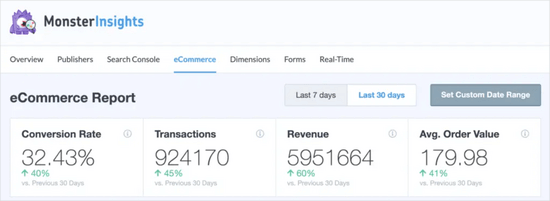
The MonsterInsights eCommerce report lets you view your revenue, number of transactions, conversion rate, and average order value at a glance.
MonsterInsights also shows the most popular products on your WooCommerce store and helps you find out which products generate the most sales and revenue.
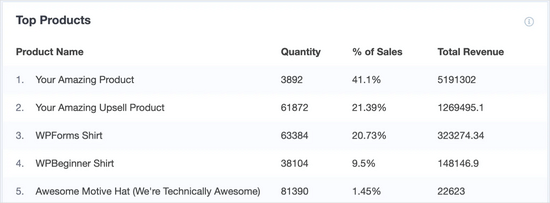
Using this information, you can offer similar products and services that your customers prefer and grow your eCommerce revenue.
We also like that the plugin tracks your top conversion sources so you can see which websites are sending you high-converting traffic. This helps you to invest more in marketing strategies that are already proven to work.
Then, you can view more shopper behavior reports in your WordPress dashboard. For instance, MonsterInsights shows you the total items added to the cart, removed from the cart, time to purchase, and sessions to purchase a product.
What’s more, it’s simple to add annotations to your MonsterInsights reports when you make key changes to your site, like publishing a new landing page, running an ad campaign, or adding a new product. This makes it easier to track which events make an impact on your website traffic.
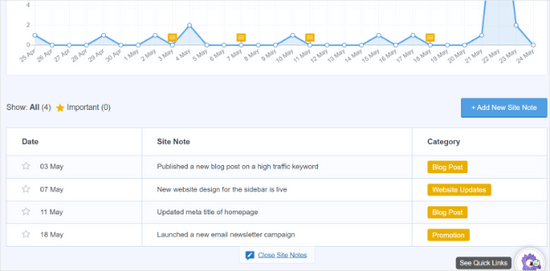
Another advantage of using MonsterInsights is its ‘Popular Products’ feature.
This feature lets you easily display your top-selling products anywhere on your WooCommerce store.
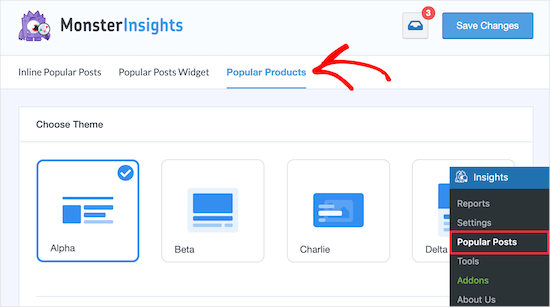
We also appreciate that MonsterInsights offers multiple themes.
What’s more, it provides different options for customizing and displaying popular products on WooCommerce product pages.
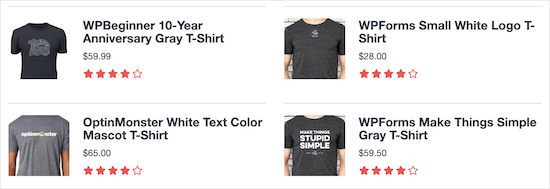
Other than that, you also get advanced tracking features with MonsterInsights. For instance, it helps you set up custom dimension tracking, scroll tracking, link click tracking, outbound link tracking, and much more.
Pros:
- Lots of metrics tracking like revenue, conversion rate, average order value, etc
- All reports are customizable
- You receive audience insights like demographics and behavior
Cons:
- Only for WooCommerce and not for Shopify
Why We Recommend Using MonsterInsights: Unlike basic Google Analytics, MonsterInsights translates complex datasets into actionable insights that are easy to understand. It helps identify top referral sources, which products are performing best, and where improvements are needed. It’s our top choice because of its diverse metric tracking and ease of use.
Pricing: To track your WooCommerce store in Google Analytics, you’ll need the MonsterInsights Pro plan, which will cost you $199.50 per year. There is also a free version, but it doesn’t include an enhanced eCommerce tracking report.
Alternative: OnePageGA is a simple and easy-to-understand dashboard for Google Analytics 4. There’s no plugin to install and it includes 25+ pre-built reports, eCommerce revenue tracking, and more.
2. WP Mail SMTP
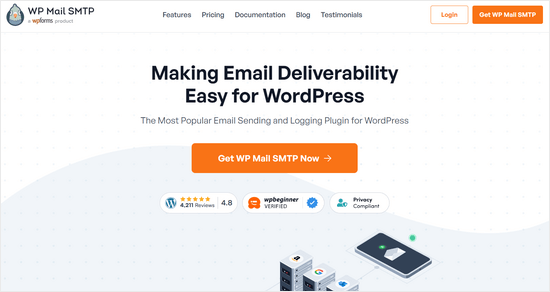
WP Mail SMTP is a must if your WooCommerce store sends emails (which it probably does). That’s because it ensures that all your emails reach your customers’ inboxes. We’ve included it on this list because it also offers essential email tracking and reporting features.
We use it ourselves to improve email deliverability on our site. Plus, we did a deep dive into its features, which you can see in our WP Mail SMTP review.
In our opinion, WP Mail SMTP is essential for all online stores because they send out tons of emails by design. Think about it, you’ll need to send customers receipts of their purchases, order details, user account information, order confirmation emails, and much more.
If your customers aren’t getting these important emails, then it will result in a bad user experience, and you’ll lose potential customers.
With WP Mail SMTP, you can track whether your emails are being delivered or not. All you have to do is enable the email logs in WP Mail SMTP, and the plugin will take care of the rest.
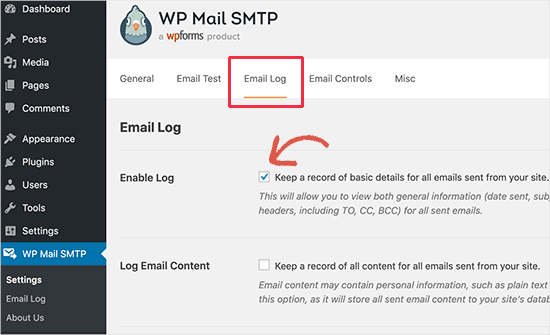
When using this plugin, we have seen how you can easily view your email logs directly inside the WordPress dashboard, which is super convenient.
Here, you can access each email’s delivery status, opens, and clicks, which is great for tracking.
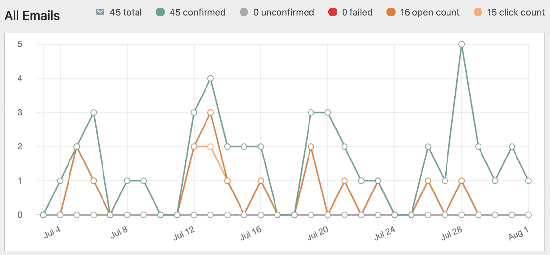
For more information, you can follow our step-by-step tutorial on how to set up WordPress email logs.
Pros:
- Free version available
- Improves email deliverability
- Tracks all emails sent to confirm successful deliveries
Cons:
- Configuration may be a little confusing if you’ve never delivered emails from SMTP before
Why We Recommend Using WP Mail SMTP: WP Mail SMTP provides detailed logs and reporting on transactional emails, which are important for eCommerce operations. Confirming that customers receive order confirmations, shipping updates, and password resets is essential for customer service and reduces support queries.
Pricing: WP Mail SMTP premium plans include the email logs feature, starting from $39 per year.
3. FunnelKit Automations
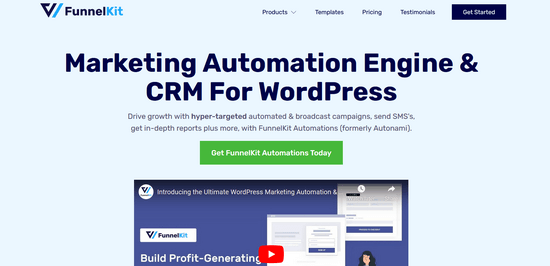
FunnelKit Automations is a marketing automation engine and CRM that you can use to easily create automated and personalized email marketing campaigns for WooCommerce. Then, you’ll be able to track the entire customer journey with its user-friendly analytics tools.
We have tested it thoroughly to learn about all its features, which you can see in our complete FunnelKit Automations review.
We like that the drag-and-drop email builder and pre-made workflows make it easy to quickly set up sequences for abandoned cart recovery. When testing, we also learned that you can create next-order coupons, subscription renewal reminders, and much more.
Another standout feature is the access to complete campaign analytics to track your emails’ performance in real-time. You can view important insights such as orders placed, carts recovered, revenue, new subscribers, unsubscribes, click-through rates, among others.
There’s also a contact journey feature that allows you to enter a contact’s name and see the automation stage they are in.
Plus, using the built-in CRM, you can keep track of all of your customers and their purchase history in one place. We like that we can easily see the orders they placed, items they purchased, coupons that were redeemed, and more.
Pros:
- It features a drag-and-drop interface, making it easy to design and modify workflows
- Offers ready-made templates for common marketing campaigns
- Provides detailed insights into the performance of marketing campaigns and automation
Cons:
- Linking your email-sending service takes an additional step to set up your account
Why We Recommend Using FunnelKit Automations: We like FunnelKit Automations as the best choice for optimizing your conversion rates for sales funnels. It tracks the entire customer journey from when they land on your site to all of the email campaigns sent.
Pricing: FunnelKit Automations starts at $249.50 per year. This also includes the FunnelKit plugin, one of the best sales funnel plugins on the market.
4. Product Sales Report for WooCommerce

Product Sales Report for WooCommerce is a great reporting tool for finding out how many sales your eCommerce store is making and then sharing the sales reports with others.
When reviewing the plugin, we noticed that it was created by Aspen Grove Studios. While we don’t use it on our sites, we downloaded and tested it thoroughly to learn about all its features
During testing, we found that we could change the reporting period and select which products to include in the sales report.
There are also different options for showing reporting fields in the report. For instance, you can show product ID, SKU, name, quantity sold, gross sales, product category, and more.
The best part about using Product Sales Report for WooCommerce is that you can generate and view the sales report inside your WordPress dashboard and download it as a CSV file to share with others.
Pros:
- Offers extensive options to customize which data is included in reports
- Reports can be downloaded in various formats, such as CSV, XLSX, and HTML
- Allows detailed filtering by date, order status, product categories, and more
Cons:
- The interface can feel overwhelming for beginners.
Why We Recommend Using Product Sales Report for WooCommerce: The Product Sales Report for WooCommerce is a great choice for businesses that really want to dig into their sales data. It’s super convenient because it lets you tweak reports to get exactly the info you need. This could involve anything from checking out how specific products are doing to getting the big picture with comprehensive order summaries.
Pricing: You can use the Product Sales Report for WooCommerce for free. However, you can also subscribe to its premium version for more reporting features, with prices starting from $199 per year.
5. Conversios

The next plugin on our list is the Conversios, formerly known as the Enhanced Ecommerce Google Analytics Plugin. On top of the usual Google Analytics integration, this tool lets you connect your Google Ads and Google Merchant accounts.
In our opinion, Conversios is very useful for unlocking various eCommerce reports directly within Google Analytics.
The downside is that you don’t get to see reports inside your WordPress dashboard like you can with MonsterInsights.
However, we like that it lets you unlock different Google Analytics eCommerce reports and view them in your Analytics. These include the shopping behavior report, checkout behavior report, product performance report, and sales performance report.
Pros:
- Works with Google Ads and Google Merchant
- Offers precise sorting and filtering options, helping to zero in on what’s important
- Enables you to save and reuse report setups or share presets across WooCommerce stores
- Incorporates conditional logic and dynamic reporting ranges to fine-tune the data displayed
Cons:
- Setting up reports can be time-consuming since each report requires manual configuration
Why We Recommend Using Conversios: Conversios is handy if you want to dive deep into your sales and product stats. It’s packed with customizable features that let you filter your data however you want. It’s specifically helpful if you run Google Ads or use Google Shopping.
Pricing: Google Analytics and Google Shopping plugin for WooCommerce is available for free.
6. Abandoned Cart for WooCommerce

Abandoned Cart for WooCommerce is one of the best WooCommerce reporting and analytics plugins to have on your website. It’s designed specifically to track abandoned carts and help recover lost sales.
An abandoned cart occurs when people visit your WooCommerce store and add products to the cart but then leave without checking out. As a result, you lose potential customers and sales.
Our experience with the plugin was great. When testing it out, we discovered that we can easily track abandoned users and see a report inside your WordPress dashboard. You’ll also get to see a complete list of abandoned carts, capture customer emails at checkout, and see from which page the user left your store.
Another advantage of using the plugin is that it helps create workflows for abandoned customers and send automated emails to abandoned users.
Pros:
- Free to use
- Able to track abandoned carts to see how your recovery campaigns are performing
- Helps to create workflows for automated abandoned cart emails
Cons:
- It’s not very useful besides tracking abandoned carts
Why We Recommend Using Abandoned Cart for WooCommerce: We highly recommend the Abandoned Cart for WooCommerce plugin, especially if your business is looking to recover lost sales and engage potential customers who didn’t complete their checkout.
Pricing: Abandoned Cart for WooCommerce is a free plugin. If you upgrade to the paid version, then you get advanced features like instant notifications when cart abandonment happens.
7. Metorik
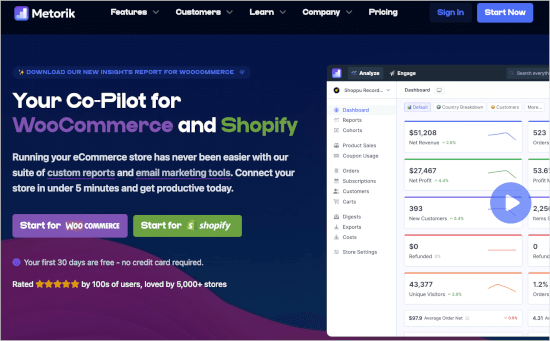
Metorik is a useful reporting and analytics tool for WooCommerce that helps you track your store’s performance. Due to its advanced real-time and segmentation features, it can be a good choice for larger stores.
During our research, we found that Metorik allows access to real-time data on many key metrics, such as revenue, sales, and customer behavior.
What makes Metorik unique is that it provides advanced segmentation options. For example, you can filter data by date range, customer group, product category, and more.
Then, you can analyze that data so that you can spot trends and gain insights so you can make smarter decisions.
We also appreciate that Metorik offers seamless integrations with some of the most popular third-party tools, such as Zapier, Mailchimp, and Google Analytics. This ensures data is shared safely between platforms.
With Metorik, you can also easily customize your dashboards so all of the most important metrics are easily accessible and top of mind
Pros:
- Lots of integrations, including help desk plugins
- Comprehensive data reports
- Able to use data for more targeted email marketing campaigns
Cons:
- No free plan is available
Why We Recommend Using Metorik: We like Metorik because it offers a cleaner interface than the reports from WooCommerce. It’s great for big stores since you don’t need to wait for reports, you get everything in real-time, and you get to create customer segments for personalization.
Pricing: Starting at $20 per month for up to 100 orders per month. They also offer a 30-day free trial.
What WooCommerce Metrics and KPIs Should You Be Tracking?
Keeping tabs on the right WooCommerce metrics is key to making smart, data-backed decisions. Here are the metrics you should keep an eye on:
- Conversion rates: You want to maximize each person that comes to your store. If they leave your site, the chances of them returning are slim to none. Add pop-ups, spin-a-wheel coupons, or even social proof on your product pages to help prevent them from bouncing before making a purchase.
- Cart abandonment rates: It can be frustrating to know that your customers leave during checkout. You may want to examine your customer journey. Maybe they checkout due to an unexpected shipping fee. But a simple exit-intent pop-up with a shipping discount can make a world of difference.
- Inventory turnover: You should know exactly how much you’re selling. That way, you’re never out of stock frantically having to turn down customers in the process.
- Bounce rates: Do your visitors frequently leave your site without fully exploring what you have to offer? In that case, you may want to use heatmap tools to see why visitors are leaving. You could also optimize your page speeds, UI design, or website content.
- Net profit: Making sales is great and all, but you need to keep an eye out for your profits as well. You can increase profits by offering cross-sells and upsells during checkout or on the thank you page.
- Customer retention rates: Do you often get repeat purchases? Consider offering a membership program so customers pay you every month.
What Is the Best WooCommerce Reporting Plugin?
When it comes to picking the right WooCommerce reporting plugin, the best choice depends on your specific goals and needs. Whether you’re looking for detailed insights, marketing automation, or real-time data tracking, each tool brings unique benefits to the table.
Based on our findings, here are our top 3 recommendations to help you get the most out of your store’s analytics:
- MonsterInsights is the best choice for comprehensive tracking and actionable insights. Its WooCommerce integration simplifies eCommerce analytics, providing detailed data like revenue, popular products, and conversion sources. Plus, you can view everything within the WordPress dashboard, so it’s super user-friendly.
- FunnelKit Automations is ideal for marketing-focused stores aiming to increase conversion rates. It offers automation for abandoned cart recovery, customer journeys, and email marketing, with real-time campaign analytics. The drag-and-drop interface and pre-made templates help create efficient workflows.
- Metorik is great for larger stores needing real-time data and advanced segmentation. Metorik supports integrations like Zapier and Google Analytics, enabling data-sharing across platforms. Its customizable dashboards and comprehensive reports help businesses stay on top of key metrics.
These selections offer different strengths depending on your needs, whether it’s a versatile all-in-one solution, marketing automation, or real-time reporting for large-scale operations.
FAQs About the Best WooCommerce Reporting Plugins
With so many features and options, it’s natural to have questions about which reporting plugin is best for your WooCommerce store.
Here are some frequently asked questions (and answers) to clear up any doubts.
What are reports in WooCommerce?
Reports in WooCommerce provide insights into your store’s performance. They often include data on sales, orders, customers, and products, helping you analyze revenue, track trends, and make data-driven decisions.
How do I get WooCommerce reports in WordPress?
WooCommerce has a ‘Reports’ section where you can view your sales, customers, stock, and taxes. This allows you to stay on top of your store’s performance. You can see which products are flying off the shelves, who’s buying what, and how much revenue you’re pulling in.
How do you get sales reports from WooCommerce?
You can get sales reports from the WooCommerce dashboard under the ‘Analytics’ or ‘Reports’ section. There, you can view detailed sales metrics, including revenue, number of orders, and product performance.
Which plugin is best for WooCommerce conversion tracking?
MonsterInsights is the best plugin for WooCommerce conversion tracking. It offers an easy setup and detailed reports directly in your dashboard, including metrics like revenue, conversion rates, and top-performing products.
Can I customize reports in WooCommerce analytics plugins?
Absolutely! The best WooCommerce reporting and analytics plugins, like MonsterInsights, allow you to tweak reports to fit just what you need to see.
Whether it’s zeroing in on sales trends, customer habits, or stock levels, you can often rearrange and filter the data to match your business’s unique needs. This way, your dashboard only displays the metrics that matter most to your business.
We hope this article helped you pick the best WooCommerce reporting and analytics plugin. You may also want to look at our guides on how to plan a holiday sale for your WooCommerce store and how to do A/B split testing in WordPress.
If you liked this article, then please subscribe to our YouTube Channel for WordPress video tutorials. You can also find us on Twitter and Facebook.





Jiří Vaněk
Reports from my online store are very important to me, and there are a huge number of plugins available. This article helped me prioritize what I want to monitor, why, and with which plugin. For me, the best ones are WP SMTP Mail and Monster Insight. These two plugins have helped me organize my reports and determine what works and what doesn’t. These plugins are invaluable.
kzain
This article is a lifesaver! I was drowning in all the WooCommerce reporting plugins out there. This breakdown, though, makes everything crystal clear. The pros and cons of each plugin are laid out perfectly, helping me choose the right one for my store. Huge thanks for the valuable insights!
Dayo Olobayo
I was overwhelmed by the numerous reporting plugins available for WooCommerce but this article broke it down in a way that made sense to me. The pros and cons of each plugin are clearly outlined making it easy for me to make an informed decision. Thanks a lot for the valuable insights.
Jiří Vaněk
Exactly as you mentioned, Dayo Olobayo, there are so many plugins for WordPress and WooCommerce today that it can be quite challenging to figure out which one is truly the best. Often, you end up searching by trial and error to find what might work best. Thankfully, we have such an amazing team of people who provide this information for free on this site. It really saves a lot of time when you get precisely targeted advice on what actually works.